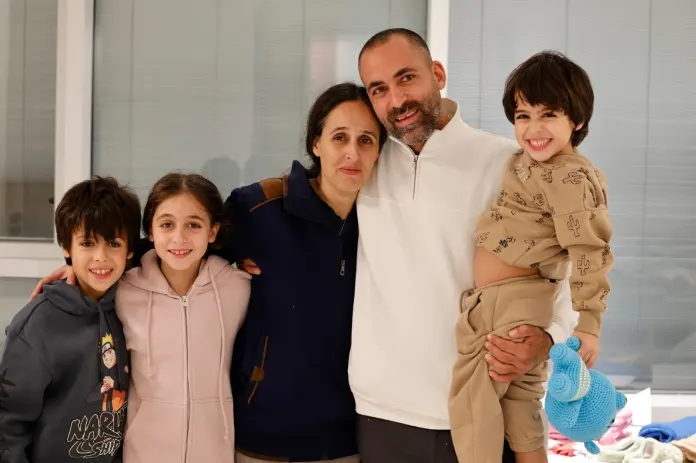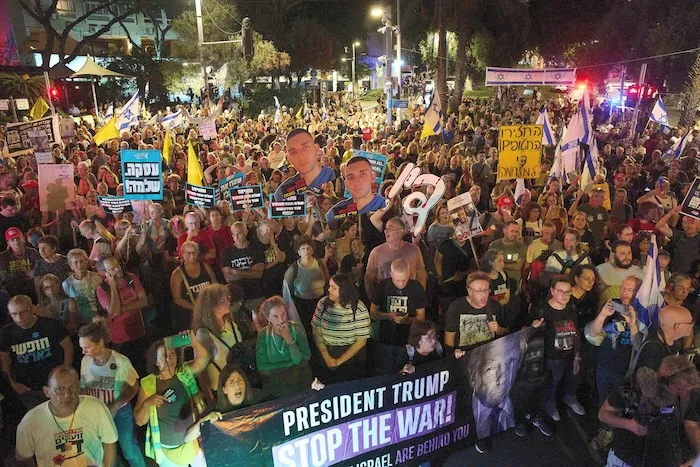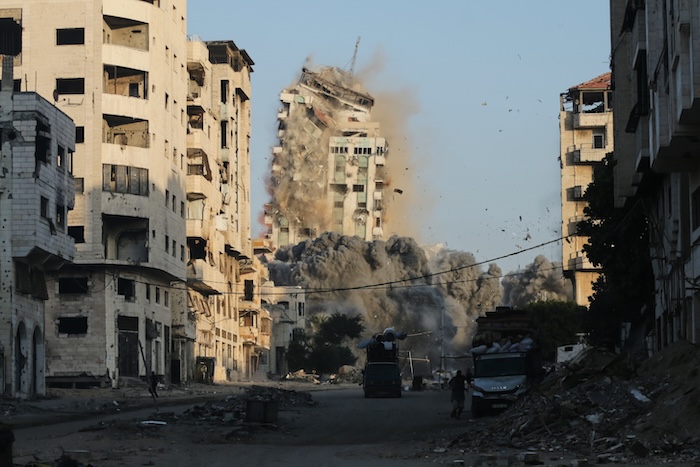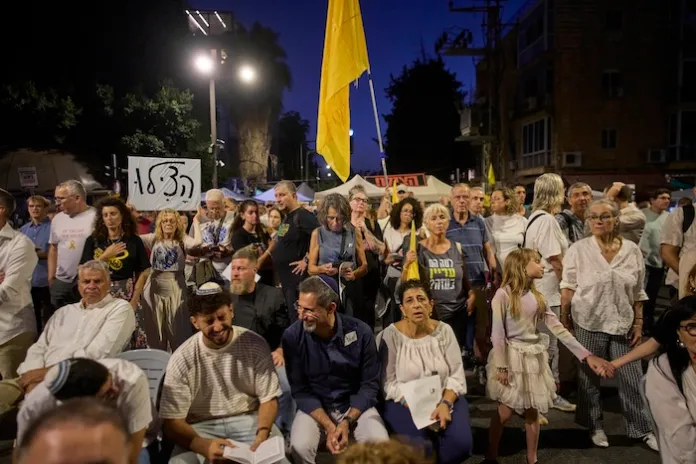Two years ago, on the morning of Oct. 7, 2023, the Brodutch family was among countless Israeli families who were awoken by the sirens that signal a present threat.
Avicahi Brodutch, the family patriarch, ushered his wife and children into their safe room as he went to the armory. He, like many others, tried to fend off the Hamas terrorists that infiltrated southern Israel in what became the worst terrorist attack in the country’s history.
He was injured by shrapnel fighting Hamas militants in his community of Kfar Aza and was hospitalized, while his wife, three children, and their neighbor’s child, an American girl named Abigail Idan, who was orphaned in the attack, were among those kidnapped and brought back to Gaza.
TRUMP ADVISES THAT ANYONE BURNING AMERICAN FLAG WILL BE IMPRISONED FOR A YEAR

His story is one shared by many Israelis whose lives were forever changed that day.
Once he was out of the hospital, Avichai protested outside the defense ministry complex in Tel Aviv, calling on the government to secure the release of the hostages. Avichai’s wife and children were held by Hamas for 51 days, and were ultimately released on the third day of the first temporary ceasefire back in late November 2023.
“It was probably the happiest call I ever got in my life,” Avichai told the Washington Examiner of when he was informed of their impending release, adding that he rushed home to get some comfort items for his children to help ease their return.
“I waited on the sixth floor [of Schneider-Children’s Medical Center], watching from the big window there to see the helicopter land and my family there. It was on the sixth floor so they had to go up and in front of the elevator, waiting for the doors to open and see my family back after so long, after Oct. 7, I thought that they were all slaughtered,” he said.
Avichai said his family is “still living” through the trauma of their time held by Hamas. They have not returned to Kfar Aza, a community that is near the Gaza border, and try to avoid the news.
“Of course, around Oct. 7, we talk about it a lot, especially now the kids talk a lot about what they went through in Gaza, and about the friends that we miss, and the war obviously hasn’t finished yet, and so it’s always in the news,” he added. “Even if we don’t watch TV, and we don’t watch TV, it’s still all around us … it’s really hard not to talk about it, but a lot of our friends were killed and a lot of my kids’ friends are orphans.”
His story is similar to countless other Israelis, whose lives were transformed on Oct. 7, 2023, a day that will live on as one of the worst security failures in the country’s history. Hundreds of the people killed on Oct. 7 were attending the Nova music festival near the border when Hamas terrorists stormed the area.
One of the organizers of the festival, Rami Shmuel, told the Washington Examiner that day “turned up” his life, “from a happy man that always surrounded himself in music and joy and people and smiles and free love in the air and nature become hell, a horror scene.”
“They took the most pure thing in the world of happiness and joy and love and turned it into a massacre,” he said. “They came with hate in their eyes and evil in their hearts, and they came to butcher, and they came to kill anything that moves.”
Roughly 200 hostages have been freed, primarily during two temporary ceasefires, while there are 48 people who are still being held by Hamas or other Gaza-based terrorist groups. 20 of the remaining hostages are believed to still be alive, now two years after being taken into captivity.

Many of the families have participated in protests against the Israeli government for not agreeing to more concessions even if it meant getting the hostages returned, as they desperately hope for an end to the war and the return of their loved ones.
Palestinians live with Hamas’s actions
In Gaza, Palestinians are facing the consequences of Hamas’s attack.
The Israeli government declared war on Hamas in the immediate aftermath of the attack with leaders expressing the goal to completely demilitarize Hamas and to remove them from power in Gaza.
They have killed thousands of Hamas terrorists and gone after those responsible for the planning of the Oct. 7 attack, but the toll on Palestinians has been incalculable as well. The Gaza Health Ministry, which is controlled by Hamas, has tallied more than 66,000 deaths from Israel’s military operations, though that total does not distinguish between civilians and combatants.
“Palestinians in Gaza have nowhere safe to go,” Annie Shiel, an advocacy director with the Center for Civilians in Conflict, told the Washington Examiner. “They have endured constant bombardment, displacement and starvation. They have seen loved ones die or disappear under rubble. They struggle to find food, clean water, and shelter.”
“Israeli military attacks, often using bombs made in the United States, have destroyed homes, schools, hospitals, entire neighborhoods, making Gaza all but unlivable,” she added.
Parts of Gaza have faced a “man-made” famine that “can be halted and reversed,” according to an August report by the United Nations-backed Integrated Food Security Phase Classification (IPC), as a result of Israel’s restrictions of aid into to the besieged enclave and the difficulty of getting it to civilians in need.
“The main thing that we’ve tried to get across as a humanitarian organization is that the humanitarian situation on the ground is not sustainable,” Kelly Razzouk, the Vice President of International Rescue Committee (IRC), told the Washington Examiner, noting that the report found that at least 132,000 children under the age of five are expected to suffer from acute malnutrition between now and the middle of next year.
“When children are so acutely malnourished they need a therapeutic food that can help to restore their health in a matter of weeks. We use community-based screening and have workers that work within the communities to measure this among the population, the children, to be able to provide this to them,” Razzouk added.

The IRC recently had to pause humanitarian operations in Gaza City due to the Israeli military’s renewed operations in the area.
Roughly 70% of the buildings in Gaza have been partially or completely destroyed, the Middle East Monitor reported in July, citing new satellite analysis by the Hebrew University’s Geographic Information System (GIS) Center.
POLITICAL VIOLENCE ON THE RISE IN THE US: A TIMELINE OF KEY INCIDENTS
Leaders across the world have called for Hamas to release the hostages and for a ceasefire for nearly the entire two years, but Hamas and Israeli leadership have refused to budge in their demands for how the conflict will end, and in allowing the conflict to persist, will further the suffering of the communities already traumatized by two years of conflict. Those efforts took a new turn last week when President Donald Trump announced his 20-point plan for ending the war and the future governance of Gaza.
As the war in Gaza has unfolded, Israeli forces have carried out operations against Hezbollah in Lebanon and against the Houthis in Yemen, both of which were carrying out attacks against Israel. Israel also engaged in a 12-day war with Iran, targeting their nuclear program. Syrian dictator Bashar al-Assad, a long-time ally of both Hezbollah and the Supreme Leader in Iran, was pushed out of power late last year as his allies were not able to help him thwart the revolution that brought down his reign.
, 2025-10-06 09:00:00,  , Washington Examiner, %%https://www.washingtonexaminer.com/wp-content/uploads/2023/11/cropped-favicon.png?w=32, https://www.washingtonexaminer.com/feed/, Mike Brest
, Washington Examiner, %%https://www.washingtonexaminer.com/wp-content/uploads/2023/11/cropped-favicon.png?w=32, https://www.washingtonexaminer.com/feed/, Mike Brest
